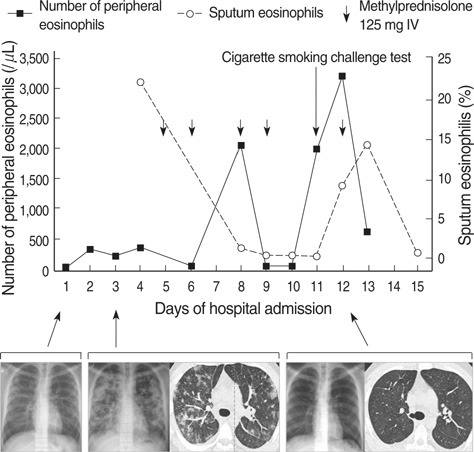J Korean Med Sci.
2008 Feb;23(1):134-137. 10.3346/jkms.2008.23.1.134.
Cigarette Smoking-Induced Acute Eosinophilic Pneumonia: A Case Report Including a Provocation Test
- Affiliations
-
- 1Division of Respiratory and Allergy Medicine, Department of Internal Medicine, Soonchunhyang University School of Medicine, Seoul, Korea. uhs@hosp.sch.ac.kr
- 2Department of Radiology, Soonchunhyang University School of Medicine, Seoul, Korea.
- 3Department of Pathology, Soonchunhyang University School of Medicine, Seoul, Korea.
- KMID: 1786860
- DOI: http://doi.org/10.3346/jkms.2008.23.1.134
Abstract
- The mechanism and cause of acute eosinophilic pneumonia are largely unknown. Many factors including the smoking of cigarettes have been suggested, but none have been proven to directly cause acute eosinophilic pneumonia. The authors report a case of acute eosinophilic pneumonia in a young Asian male who recently started smoking. The diagnosis was made based on his clinical course and results of chest radiography, lung spirometry, bronchoalveolar lavage, and transbronchial lung biopsies. After administration of methylprednisolone, his clinical course rapidly improved. A provocation test was designed to establish a connection between cigarette smoking and the development of acute eosinophilic pneumonia. After the provocation test, the patient showed identical symptoms, increase in sputum eosinophils, and worsening of pulmonary function. The results of the provocation test suggest that smoking may directly cause acute eosinophilic pneumonia, and support previous reports of cigarette smoking-induced acute eosinophilic pneumonia.
MeSH Terms
Figure
Reference
-
1. Allen JN, Pacht ER, Gadek JE, Davis WB. Acute eosinophilic pneumonia as a reversible cause of noninfectious respiratory failure. N Engl J Med. 1989. 321:569–574.
Article2. Allen JN, Davis WB. Eosinophilic lung diseases. Am J Respir Crit Care Med. 1994. 150:1423–1438.
Article3. Watanabe K, Fujimura M, Kasahara K, Yasui M, Myou S, Kita T, Watanabe A, Nakao S. Acute eosinophilic pneumonia following cigarette smoking: a case report including cigarette-smoking challenge test. Intern Med. 2002. 41:1016–1020.
Article4. Shintani H, Fujimura M, Ishiura Y, Noto M. A case of cigarette smoking-induced acute eosinophilic pneumonia showing tolerance. Chest. 2000. 117:277–279.
Article5. Nakajima M, Manabe T, Niki Y, Matsushima T. Cigarette smoke-induced acute eosinophilic pneumonia. Radiology. 1998. 207:829–831.
Article6. Pope-Harman AL, Davis WB, Allen ED, Christoforidis AJ, Allen JN. Acute eosinophilic pneumonia: a summary of 15 cases and a review of the literature. Medicine (Baltimore). 1996. 75:334–342.7. Philit F, Etienne-Mastroianni B, Parrot A, Guerin C, Robert D, Cordier JF. Idiopathic acute eosinophilic pneumonia; a study of 22 patients. Am J Respir Crit Care Med. 2002. 166:1235–1239.8. Allen J. Acute eosinophilic pneumonia. Semin Respir Crit Care Med. 2006. 27:142–147.
Article9. King MA, Pope-Harman AL, Allen JN, Christoforidis GA, Christoforidis AJ. Acute Eosinophilic pneumonia: radiologic and clinical features. Radiology. 1997. 203:715–719.
Article10. Shiota Y, Kawai T, Matsumoto H, Hiyama J, Tokuda Y, Marukawa M, Ono T, Mashiba H. Acute eosinophilic pneumonia following cigarette smoking. Intern Med. 2000. 39:830–833.
Article11. Rom WN, Weiden M, Garcia R, Yie TA, Vathesatogkit P, Tse DB, McGuinness G, Roggli V, Prezant D. Acute eosinophilic pneumonia in a New York City firefighter exposed to World Trade Center dust. Am J Respir Crit Care Med. 2002. 166:797–800.
Article12. Badesch DB, King TE Jr, Schwartz MI. Acute eosinophilic pneumonia: a hypersensitivity phenomenon? Am Rev Respir Dis. 1989. 139:249–252.
Article13. Imokawa S, Sato A, Hayakawa H, Toyoshima M, Taniguchi M, Chida K. Possible involvement of an environmental agent in the development of acute eosinophilic pneumonia. Ann Allergy Asthma Immunol. 1996. 76:419–422.
Article14. Taniguchi H, Kadota J, Fujii T, Matsubara Y, Katoh S, Mukae H, Matsukura S, Kohno S. Activation of lymphocyte and increased interleukin-5 levels in bronchoalveolar lavage fluid in acute eosinophilic pneumonia. Eur Respir J. 1999. 13:217–220.15. Yamaguchi S, Okubo Y, Hossain M, Fujimoto K, Honda T, Kubo K, Sekiguchi M, Takatsu K. IL-5 predominant in bronchoalveolar lavage fluid and peripheral blood in a patient with acute eosinophilic pneumonia. Intern Med. 1995. 34:65–68.
Article16. Allen JN, Liao Z, Wewers MD, Altenberger EA, Moore SA, Allen ED. Detection of IL-5 and IL-1 receptor antagonist in bronchoalveolar lavage fluid in acute eosinophilic pneumonia. J Allergy Clin Immunol. 1996. 97:1366–1374.
Article17. Nishigaki Y, Fujiuchi S, Yamazaki Y, Matsumoto H, Takeda A, Fujita Y, Okamoto K, Fujikane T, Shimizu T, Kikuchi K. Increased vascular endothelial growth factor in acute eosinophilic pneumonia. Eur Respir J. 2003. 21:774–778.
Article18. Jo HC, Lee YJ, Park MJ, You JH, Kang HM. A case of smoking induced acute eosinophilic pneumonia. Tuberc Respir Dis. 2005. 58:515–520.
Article
- Full Text Links
- Actions
-
Cited
- CITED
-
- Close
- Share
- Similar articles
-
- A Case of Smoking Induced Acute Eosinophilic Pneumonia
- New Onset Cigarette Smoking-Induced Acute Eosinophilic Pneumonia: Case Report and Review of the Literature
- A Case of Acute Eosinophilic Pneumonia Following Cigarette Smoking
- Acute eosinophilic pneumonia caused by passive smoking
- Two Cases of Cigarette Smoking-Induced Acute Eosinophilic Pneumonia




